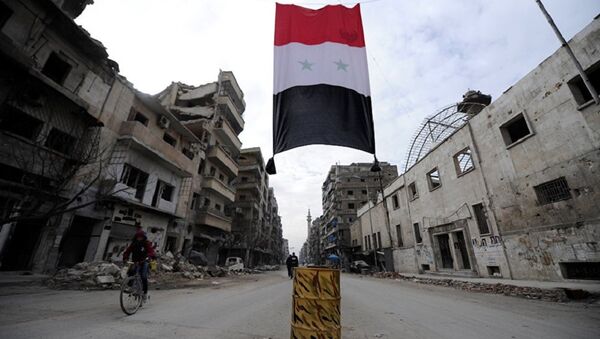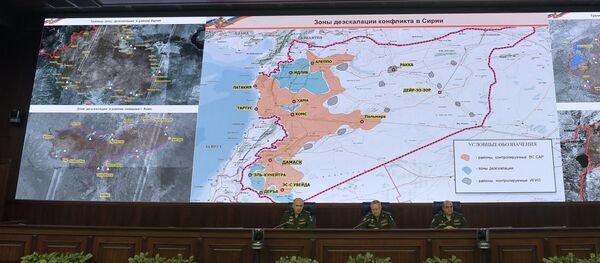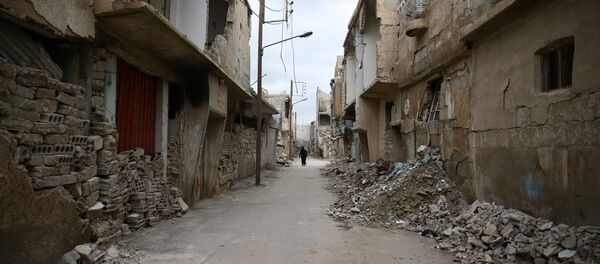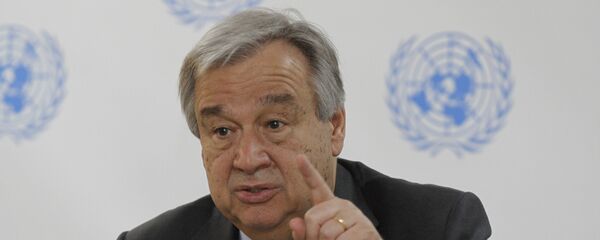The deal was discussed earlier this week during talks between Russian President Vladimir Putin and his Turkish counterpart Recep Tayyip Erdogan in Sochi. The memorandum was signed at the end of the fourth round of Syrian peace talks in the Kazakh capital of Astana.
"Guarantor states agreed to create de-escalation zones in Idlib province and parts of the neighboring provinces (Latakia, Hama and Aleppo), certain parts in the north of Homs province, Eastern Ghouta, certain parts in Syria's south (Daraa and Quneitra provinces)," the document reads.
Safe Zones Under Control of Russia, Iran and Turkey
In particular, the memorandum envisages safe areas along the borders of the safe zones to prevent direct fire between the warring parties.
Observation points will be established in those areas to monitor the ceasefire regime as well as checkpoints for civilians and humanitarian supplies.
According to Rudskoy, the activity of these check and observation points, as well as the management of the safe zones, will be carried out by military personnel from Russia, Turkey and Iran. Third parties may be included in the process as a result of mutual arrangements between the Syrian ceasefire guarantor states.
The first and largest safe zone is planned to be established in the Governorate of Idlib, in northern Syria, as well as in bordering northeast areas in Latakia, in western parts of Aleppo and part of Hama. According to estimates by the Russian military, there are over one million people in the region. It is controlled by nearly 14,500 militants.
The second zone is located between Hama and Homs, the centers of the eponymous provinces, and includes such cities as Ar-Rastan and Tell Bisa. There are some 180,000 civilians in the region and it is currently controlled by up to 3,000 militants.
According to Rudksoy, the Ghouta safe zone does not include the area of Qaboun, which is completely under control of al-Nusra Front. The militants regularly shell Damascus, including the territory near the Russian embassy.
Finally, the forth safe zone will be established in southern Syria, along the border with Jordan, in Deraa and Quneitra provinces. The area has a total population of up to 800,000 and is controlled by 15,000 jihadists and "moderates."
Currently, Russian troops in Syria under the leadership of the General Staff are estimating the number of necessary observation points, which will be established in the safe zones.
Keeping Hopes Up
The guarantor states will create a joint working group in two weeks, which will present the exact borders of the safe zones and security lines by June 4, according to Rudskoy added. Maps dissociating formations of armed opposition from Daesh and al-Nusra Front will also be presented.
Russia, Iran and Turkey will continue the fight against the terrorists and affiliated groups, including within the de-escalation areas. They will also assist the Syrian Army and Syrian opposition armed formations. Syrian troops withdrawn from the safe zones will be deployed to continue an offensive against Daesh in central and eastern parts of the country, including in the area of the Euphrates, with support from the Russian Aerospace Forces.
According to Rudskoy, the Russian aviation Russian Aerospace Forces has already ceased activities in the safe zones defined by the memorandum.
"The use of the aircraft of the Russian Aerospace Forces in areas corresponding to the de-escalation zones defined by the memorandum was stopped as of 00.00 on May 1," Rudskoy said.
The city is the regional stronghold of the Jaysh al-Islam opposition group, which has joined the ceasefire and begun an offensive against Daesh and groups affiliated with the terrorists.
According to Rudksoy, earlier this week, Russian troops and four unmanned aerial vehicles accompanied the convoy of 51 trucks carrying food and medicine to eastern Ghouta. He also said that identified and disarmed a suicide attacker attempting to target the humanitarian aid convoy.
"As the humanitarian convoy was passing through a checkpoint on the demarcation line, the Russian military servicemen identified, disarmed and handed over to Syria’s security service representatives a suicide attacker, who possessed 10 kilograms of explosives and grenades," Rudskoy said.
The talks in Astana are distinguished by the fact that from the Syrian opposition they involve not "politicians and immigrants," but actual field commanders "controlling the situation on the ground," Russian Deputy Defense Minister Lt. Gen. Alexander Fomin said.
According to him, despite the standoff between the militants and the Syrian Army, "those people realize their responsibility for the future of the integrated state of Syria."
Fomin noted that during the "frank talks" in Astana the memorandum was agreed with 27 field commanders operating in the de-escalation areas.
He also expressed hope that the implementation of the plan will put an end to the six-year-long civil war in Syria.
"The implementation of the memorandum will allow for stopping the combat activities by warring sides and practically put an end to the civil war in Syria, which is why the document is of great importance for the political settlement in the country," Fomin said Friday.
As additional measures, the warring parties are expected to initiate prisoners exchange and humanitarian mine clearance.
Approved by the US and Saudi Arabia
According to Fomin, the memorandum was prepared at the direct request of Russian President Vladimir Putin.
"The issue of political settlement in Syria has been repeatedly discussed by the Russian president with the leadership of Turkey, the United States and other countries. In particular, de-escalation zones were discussed during the talks between Putin and Erdogan in Sochi," he said.
In turn, Russian Defense Minister Sergei Shoigu had several working meetings with his counterparts from Iran, Turkey, Syria and Israel.
Permanent contacts were also established between intelligence agencies and diplomats.
According to him, the memorandum has also been supported by the United Nations (UN), the United States, Saudi Arabia other countries, which guarantees its implementation.
"The position of the United States, which welcomed the steps to reduce violence in Syria, improve the humanitarian situation and create conditions for a political settlement of the conflict, positively influenced the creation of de-escalation zones," Fomin said.
The initiators of the plan expect that the memorandum will ensure to rebuild Syria’s infrastructure, including water and power supplying systems, as well as to create safe conditions for refugees to come back to Syria and finally bringing peace to the war-ravaged country.
Never miss a story again — sign up to our Telegram channel and we'll keep you up to speed!








